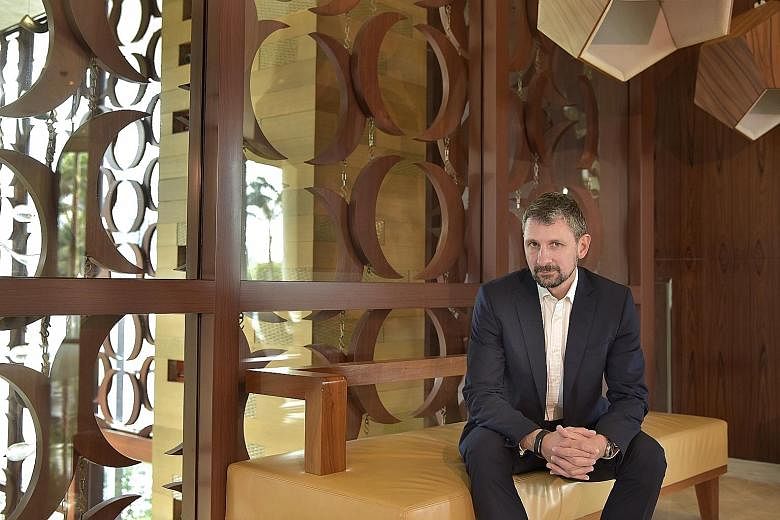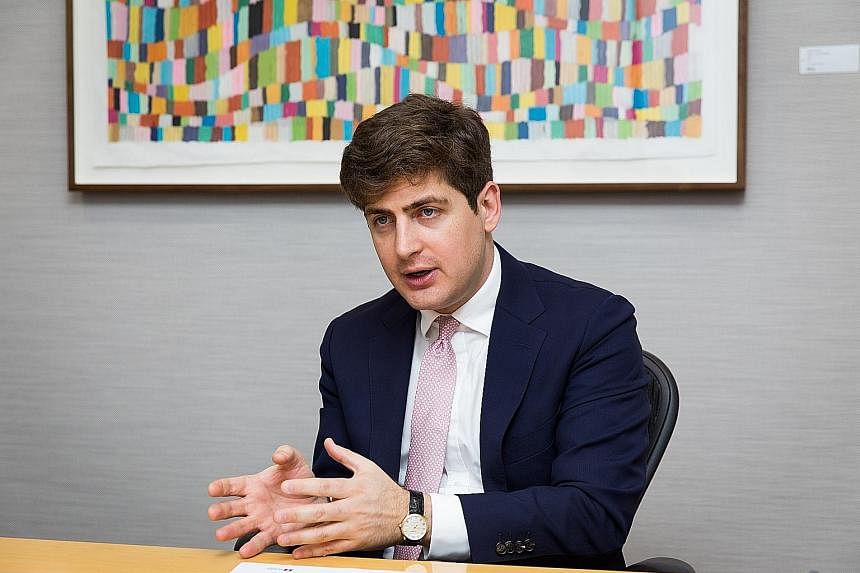Mr Eugene Philalithis, who heads Fidelity's multi-asset income team, has almost 20 years of investment experience. He is also the lead portfolio manager for the firm's Global Multi Asset Income Fund, which he manages alongside co-portfolio manager George Efstathopoulos.
Launched in 2013, the fund aims to provide income and moderate capital growth in the medium to longer term by investing globally and in investment-grade, high-yield and emerging market bonds, and equities. The Global Multi Asset Income Fund A-Mincome(G)-SGD (SGD/USD hedged) share class is available to retail investors here and eligible for Supplementary Retirement Scheme funds. In the 10 months to Oct 31, the share class generated returns of 6.3 per cent.
Q What do you see as the major challenge facing investors today?
Mr Philalithis: This is potentially the most difficult environment since the global financial crisis, with yields at record lows across asset classes and central banks raising rates as we enter the late stage of the equity bull market. The late stage is often the hardest to navigate, but is particularly difficult now, with investors facing a scarcity of safe-haven assets.
Quantitative easing has driven up asset prices and pushed down yields, forcing investors to look more widely for income. This has continued into this year, with investors' demand for fixed-income leading to lower yields and the stable macro backdrop encouraging investors to accept less compensation for risk.
Tactically allocating to markets during periods of weakness will be important to building defensive valuation protection and maintaining yield levels in the next few years.
Q What options do investors have to address that challenge?
Mr Philalithis: Multi-asset income strategies are designed to address that challenge. We have two broad responses. Invest in a highly diversified portfolio across a broad range of asset classes with different and uncorrelated return drivers. This includes allocating to non-traditional assets like loans and infrastructure, with the latter, in particular, relatively insulated from the impact of quantitative easing.
Maintain a flexible approach to asset allocation. The key lesson from the financial crisis was that you need a high degree of flexibility to protect investors on the downside and deliver proper defensiveness when the time comes.
Q What makes your approach to income investing different?
Mr Efstathopoulos: We look to build a truly diversified portfolio, diversifying horizontally across regions and vertically across the capital structure. This includes investing in non-traditional asset classes like loans, which have useful interest rate properties for an income portfolio.
Global diversification is an important tenet of the fund, including a substantial allocation to Asian assets. Asia is becoming an important universe for income seekers, offering companies with good dividend growth prospects and deeper and more diversified bond markets.
As well as our focus on income, we focus on prudent risk management. This includes analysing and scaling positions properly, but also being careful to pay our income as natural income rather than unsustainably dipping into investors' capital.
Q What is your current market outlook?
Mr Philalithis: We are positive on the outlook for global growth in general, though we believe investors should be cautious, given latent risks from Chinese policy tightening and the potential for the US Federal Reserve to raise interest rates quicker than expected.
That said, if GDP numbers and corporate earnings continue this trajectory and inflation remains low, risks assets like equities, high-yield bonds and local currency emerging market debt should perform well.
Q Where are you finding best value?
Mr Efstathopoulos: We think bank debt and equity is one of the best-valued asset classes. Banks have significantly repaired their balance sheets since the financial crisis and are most of the way to meeting regulators' stricter capital requirements. Equity investors should therefore get a greater share of the profits, while bond holders can benefit from higher yields relative to other financial instruments and some capital upside as bank spreads narrow.
Q What are the major risks and how does fund strategy take account of them?
Mr Philalithis: One major risk is that markets are mispricing the prospect of rate rises from the Federal Reserve. While inflation data has mostly been soft this year, employment has been strong in the US, with signs that the central bank is growing more worried about risks to financial stability.
Given this and the low market pricing for rates rises, it would not take much for investors to be negatively surprised. US fixed-income markets would likely sell off, with spreads having tightened on investment grade and high-yield bonds across this year. Local currency emerging market debt could also be negatively affected in the event of a resurgent US dollar. Mr Efstathopoulos: Given this risk, we are actively reducing the fund's duration. Loans versus high-yield bonds are a key conviction view, with loans carrying virtually no duration risk due to their floating rates. Within fixed-income markets we are actively favouring markets with a shorter duration profile, such as Asian investment-grade bonds. We also like financial debt and equity, with financials one of the few sectors that actually benefit from rising rates, as well as enjoying strong secular tailwinds.
Q What is your investment advice for the Asian investor in 2018?
Mr Philalithis: One of the less commented aspects of multi-asset investing is selecting the right way to play an investment idea. Picking the right exposure can often be as important for investors as the actual idea in the first place, with investors needing to think about what they're investing for, the risks of each type of exposure and which route offers the best potential upside.
With the low-yield environment likely to extend through next year, working out your best possible exposure has never been so important.



